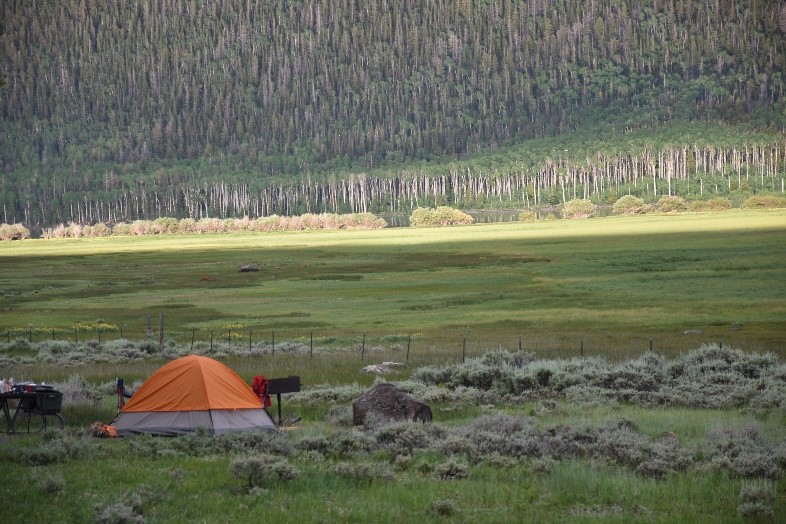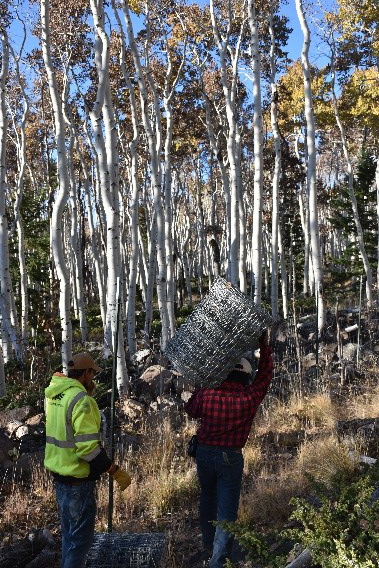Pando Update: Crafting a Course to Sustainability
While you Pandomaniacs have been scurrying around LA County giving form and function to Pando Days, it has been a busy summer of progress near Utah’s Fish Lake, home of Pando (the tree-forest). In the spirit of Pando Populus, we periodically reinvigorate that 500 mile link that shares moniker, meaning, and memories for some of you.
I wish to start off by saying that I have the great pleasure of working in beautiful places. If I didn’t stop and recognize that periodically, I might just go mad with all the other distractions, frustrations, and commotions occurring today. And now I have just completed a project linking aspen forests around the world; something I’m calling Pando to Pangea! The Pando aspen clone and surrounding Fish Lake environs are simply stunning. Whether early morning wildlife stirrings, seasonal color changes, or campfire star-gazing, Pando evokes a visceral experience with every visit.
Incremental progress in Pando’s recovery also brings a tiny sense of success in the name of our planet. In 2019, we began to see the face of progress at Pando though we have a long way to go to achieve true sustainability. This past summer we worked hard on reversing the trajectory at Pando. While temporarily setting monitoring aside, our focus this year was on bolstering the failing fences that protect Pando’s progeny from overconsumption by deer and cattle.
As you may recall, last year’s technical publication, which garnered widespread media attention, concluded that the large fenced exclosure above the highway was still allowing deer entry and severely hampering Pando’s ability to successfully reproduce. The remaining portion of Pando (approximately 50%) is completely unprotected from both deer and cattle browsing, leaving only about 17% of the entire Pando in a state of healthy recovery.
In late June, a core group composed of state, federal, and NGO personnel—collectively, Utah 
In July, a smaller contingent of volunteers, working under the banner of EXPEDITION: Pando, assembled for a few days of tent life, gate-building, and campfire conversation. While I’ll let Marc O’Brien, who spearheaded this effort, provide the full summary of that special time together, I will say that I believe that time spent working together and communing around food and fire took us to another level in terms of our appreciation of that place and the people rallying to protect it.
Another key event this summer was the opportunity to meet up with Manny Friedman and the 
Parallel to this, Lance Oditt, Pando Photographer Extraordinaire, is leading a drive to collaborate with local municipalities to promote Pando as an outdoor education resource and tourist destination. We are now working with entities in Richfield, UT to install a photo exhibition in that town that we hope will eventually be displayed in many communities around the state. Further, we plan to develop information science brochures and engage rural students in an ambitious project to photo-document the entire Pando clone. It seems we are beginning to achieve a kind of symbiosis: people and place working as one for the future of Pando!
Still, we need to think carefully about how we move forward. While fences may provide some temporary relief from chronic browsing, they may also be a barrier to societal connections to nature. The visual impact of a caged Pando may send inappropriate messages to those seeking solitude, vision, and learning in this magical place. Where do we draw the line between the “triage” of erecting walls and the unsightly image of a fenced-off forest? Can we hold fast a dream of restoring critical linkages in both an ecologically and culturally sensitive manner? Clearly, a thoughtful plan, one open to adaptive adjustments along the way, is required. I suspect this will ultimately involve technician and tinkerer, designer and deal-maker, worker and writer.
But why are we drawn to this magical grove in the first place? While Pando is an apt symbol of critical linkages—most pointedly, between humans and ecosystems—what are its tangible 
This one-tree forest holds infinite value as a tourist attraction grounded in ecological principles, restoration practices, and civic learning. Moreover, there may be economic benefits to surrounding communities, as long as we maintain an eye on potential overconsumption of Pando’s environs. Potentially, this unique forest could even be used to “market” the benefits of maintaining both physical and social interconnections, and thus serve as a model for responding to other environmental crises around the world. After all, isn’t that a reasonable application of living in a truly “ecological civilization”?
